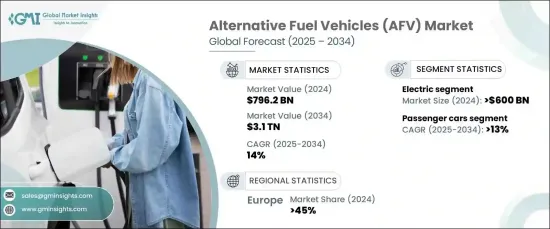
|
시장보고서
상품코드
1666608
대체 연료 자동차 시장 기회, 성장 촉진요인, 산업 동향 분석, 예측(2025-2034년)Alternative Fuel Vehicles (AFV) Market Opportunity, Growth Drivers, Industry Trend Analysis, and Forecast 2025 - 2034 |
||||||
세계 대체 연료 자동차 시장은 2024년 7,962억 달러로 평가되며 2025년부터 2034년까지 연평균 14%로 성장할 것으로 예측됩니다. 이러한 강력한 성장의 주요 요인은 지속가능한 운송 솔루션에 대한 수요 증가, 청정 모빌리티로의 전환, 환경 지속가능성에 대한 관심 증가 등입니다. 전 세계 각국 정부는 탄소 배출량을 줄이고 환경 친화적인 대안으로의 전환을 촉진하기 위한 정책을 시행하고 있습니다.

이러한 정부의 노력과 함께 전기자동차(EV) 배터리의 기술 발전과 충전 인프라의 확대는 소비자들이 전기자동차로 쉽게 전환할 수 있도록 돕고 있습니다. 또한, 기존 연료 자동차가 환경에 미치는 영향에 대한 소비자의 인식이 높아지면서 자동차 제조업체들이 친환경 솔루션 개발에 많은 투자를 하고 있는 것도 시장 성장에 힘을 보태고 있습니다. 전 세계가 기후 변화와 환경 악화에 대응하기 위해 노력하고 있는 가운데, 대체 연료 자동차는 해결책의 필수적인 부분으로 간주되고 있습니다.
| 시장 범위 | |
|---|---|
| 시작 연도 | 2024년 |
| 예측 연도 | 2025-2034년 |
| 시작 금액 | 7,962억 달러 |
| 예상 금액 | 3조 1,000억 달러 |
| CAGR | 14% |
전 세계적으로 이산화탄소 배출량 감축에 대한 필요성이 대두되면서 화석연료에 대한 의존도를 낮추는 데 점점 더 많은 초점을 맞추고 있으며, 전기자동차(EV)에 대한 대규모 투자가 이루어지고 있습니다. 정부의 보조금, 세금 감면, 전기자동차 인프라에 대한 지원으로 전기 모빌리티는 소비자들에게 점점 더 매력적으로 다가오고 있으며, 배터리 시스템의 급속한 기술 발전으로 주행거리와 충전 속도가 향상되어 전체 자동차의 편의성이 향상됨에 따라 전기자동차에 대한 수요가 증가하고 있습니다. 충전 네트워크가 확충되면서 전기자동차 보급의 큰 걸림돌이었던 주행거리에 대한 불안감이 점차 해소되고 있습니다. 전기자동차가 보다 친숙하고 저렴해짐에 따라 그 인기가 급상승하여 전체 시장 확대에 큰 기여를 할 것으로 보입니다.
시장은 연료 유형별로 전기자동차, 바이오연료, 기타 대체연료로 구분됩니다. 전기자동차 분야만 2024년 6,000억 달러의 매출을 기록했으며, 향후 몇 년 동안 큰 폭의 성장이 예상됩니다. 이러한 급격한 성장을 촉진하는 요인으로는 환경 의식의 증가, 배터리 기술의 향상, 소비자의 전기자동차 선택을 더욱 촉진하는 정부의 인센티브 등을 들 수 있습니다. 자동차 제조사들도 제품 라인의 다양화를 통해 이러한 수요에 대응하고 있으며, 이는 시장 확대에 더욱 박차를 가할 것으로 보입니다.
차량 유형별로 시장은 승용차와 상용차로 나뉩니다. 승용차 부문은 2025년부터 2034년까지 13%의 CAGR을 기록할 것으로 예상됩니다. 친환경 교통수단에 대한 수요가 급증하는 것은 주로 소비자의 선호도가 더 깨끗하고 에너지 효율적인 차량으로 이동하고 있기 때문입니다. 전기자동차 및 하이브리드 자동차 기술은 정부의 노력과 전기자동차 충전 인프라의 성장에 힘입어 더욱 발전할 것으로 예상되며, 이러한 두 가지 기술이 결합되어 더욱 매력적으로 다가올 것으로 예상됩니다.
2024년 유럽은 대체 연료 자동차 세계 시장 점유율의 45%를 차지했는데, 이는 유럽의 야심찬 탄소 중립 목표와 지속가능성에 대한 소비자의 관심 증가에 힘입은 바 큽니다. 유럽 정부는 재정적 인센티브, 보조금, 충전 네트워크에 대한 투자를 통해 전기자동차 도입을 지원하고 있으며, 항속거리 불안 등의 장벽을 극복하고 전기자동차 보급에 기여하고 있습니다.
목차
제1장 조사 방법과 조사 범위
- 조사 설계
- 조사 접근법
- 데이터 수집 방법
- 기본 추정과 계산
- 기준 연도 산출
- 시장 추정의 주요 동향
- 예측 모델
- 1차 조사와 검증
- 1차 소스
- 데이터 마이닝 소스
- 시장 범위와 정의
제2장 주요 요약
제3장 업계 인사이트
- 업계 생태계 분석
- 공급업체 상황
- 테크놀러지 프로바이더
- 서비스 프로바이더
- 제조업체
- 유통업체
- 최종 용도
- 이익률 분석
- 기술과 혁신 전망
- 특허 분석
- 규제 상황
- 비용 분석
- 사례 연구
- 영향요인
- 성장 촉진요인
- 세계의 연료 가격 상승
- 세계의 충전 인프라 확대
- 비용 효율적인 배터리에 대한 주목 상승
- 정부 인센티브와 규제 급증
- 업계의 잠재적 리스크·과제
- 높은 초기 비용
- 이용 가능한 충전 인프라가 한정적
- 성장 촉진요인
- 성장 가능성 분석
- Porters 분석
- PESTEL 분석
제4장 경쟁 구도
- 소개
- 기업 시장 점유율 분석
- 경쟁 포지셔닝 매트릭스
- 전략 전망 매트릭스
제5장 시장 추정과 예측 : 연료별, 2021-2034년
- 주요 동향
- 전기자동차
- 배터리 전기자동차(BEV)
- 하이브리드 전기자동차(HEV)
- 플러그인 하이브리드 자동차(PHEV)
- 연료전지 전기자동차(FCEV)
- 바이오연료
- 기타
제6장 시장 추정과 예측 : 차량별, 2021-2034년
- 주요 동향
- 승용차
- 해치백
- 세단
- SUV차
- 상용차
- 소형 상용차(LCV)
- 대형 상용차(HCV)
제7장 시장 추정과 예측 : 최종 용도별, 2021-2034년
- 주요 동향
- 상업·플릿
- 대중교통
- 정부·자치체
- 기타
제8장 시장 추정과 예측 : 지역별, 2021-2034년
- 주요 동향
- 북미
- 미국
- 캐나다
- 유럽
- 영국
- 독일
- 프랑스
- 이탈리아
- 스페인
- 러시아
- 북유럽
- 아시아태평양
- 중국
- 인도
- 일본
- 호주
- 한국
- 동남아시아
- 라틴아메리카
- 브라질
- 멕시코
- 아르헨티나
- 중동 및 아프리카
- UAE
- 남아프리카공화국
- 사우디아라비아
제9장 기업 개요
- Audi
- BMW
- BYD Company
- Faraday Future
- Fiat Chrysler Automobiles
- Fisker
- Ford Motor
- General Motors
- Honda Motors
- Hyundai Motor
- Kia
- Lucid Motors
- Mercedes-Benz
- Nissan Motor
- Polestar Automotive H
- Rivian Automotive
- Tesla
- Toyota Motor
- Volkswagen
- Volvo
The Global Alternative Fuel Vehicles Market was valued at USD 796.2 billion in 2024 and is projected to expand at a CAGR of 14% between 2025 and 2034. This robust growth is primarily fueled by the increasing demand for sustainable transportation solutions, a shift towards cleaner mobility, and rising concerns over environmental sustainability. Governments across the globe are rolling out policies designed to reduce carbon emissions and encourage the transition to green alternatives.

Along with these government initiatives, technological breakthroughs in electric vehicle (EV) batteries and expanding charging infrastructure are making it easier for consumers to switch to electric options. The market growth is also being propelled by greater consumer awareness about the environmental impact of traditional fuel-driven vehicles, pushing automakers to invest heavily in the development of eco-friendly solutions. As the world continues to grapple with climate change and environmental degradation, alternative fuel vehicles are seen as an essential part of the solution.
| Market Scope | |
|---|---|
| Start Year | 2024 |
| Forecast Year | 2025-2034 |
| Start Value | $796.2 Billion |
| Forecast Value | $3.1 Trillion |
| CAGR | 14% |
The increasing focus on reducing dependence on fossil fuels, in line with the need to curb global carbon emissions, has led to substantial investments in electric vehicles (EVs). Government subsidies, tax breaks, and support for EV infrastructure are making electric mobility increasingly attractive to consumers. The demand for EVs is further fueled by rapid technological advancements in battery systems, enhancing driving ranges and charging speeds, which contribute to the vehicles' overall convenience. With more extensive charging networks in place, range anxiety, a significant barrier to EV adoption, is steadily diminishing. As electric vehicles become more accessible and affordable, their popularity is set to soar, contributing significantly to the overall market expansion.
The market is segmented by fuel type into electric vehicles, biofuels, and other alternative fuels. The electric vehicle segment alone generated USD 600 billion in 2024, and it is expected to experience substantial growth in the coming years. Factors driving this surge include heightened environmental awareness, improvements in battery technology, and government incentives that further encourage consumers to opt for electric cars. Automakers are also responding to this demand by diversifying their product lines, which will further fuel market expansion.
In terms of vehicle types, the market is divided into passenger cars and commercial vehicles. The passenger car segment is anticipated to experience a CAGR of 13% from 2025 to 2034. The surge in demand for eco-friendly transportation options is primarily driven by consumer preferences shifting toward cleaner, more energy-efficient vehicles. Both electric and hybrid vehicle technologies are expected to witness advancements spurred on by government initiatives and the growth of EV charging infrastructure, which together make these vehicles even more appealing.
In 2024, Europe accounted for 45% of the global market share in alternative fuel vehicles, largely due to the region's ambitious carbon neutrality targets and increased consumer focus on sustainability. European governments are supporting EV adoption through financial incentives, grants, and investment in charging networks, overcoming barriers like range anxiety and contributing to the widespread adoption of electric vehicles.
Table of Contents
Chapter 1 Methodology & Scope
- 1.1 Research design
- 1.1.1 Research approach
- 1.1.2 Data collection methods
- 1.2 Base estimates & calculations
- 1.2.1 Base year calculation
- 1.2.2 Key trends for market estimation
- 1.3 Forecast model
- 1.4 Primary research and validation
- 1.4.1 Primary sources
- 1.4.2 Data mining sources
- 1.5 Market scope & definition
Chapter 2 Executive Summary
- 2.1 Industry 3600 synopsis, 2021 - 2034
Chapter 3 Industry Insights
- 3.1 Industry ecosystem analysis
- 3.2 Supplier landscape
- 3.2.1 Technology providers
- 3.2.2 Service providers
- 3.2.3 Manufacturers
- 3.2.4 Distributors
- 3.2.5 End Use
- 3.3 Profit margin analysis
- 3.4 Technology & innovation landscape
- 3.5 Patent analysis
- 3.6 Regulatory landscape
- 3.7 Cost analysis
- 3.8 Case study
- 3.9 Impact forces
- 3.9.1 Growth drivers
- 3.9.1.1 Increasing fuel prices worldwide
- 3.9.1.2 Expanding charging infrastructure globally
- 3.9.1.3 Rising emphasis on cost-efficient batteries
- 3.9.1.4 Surge in government incentives and regulations
- 3.9.2 Industry pitfalls & challenges
- 3.9.2.1 High upfront costs
- 3.9.2.2 Limited availability of charging infrastructure
- 3.9.1 Growth drivers
- 3.10 Growth potential analysis
- 3.11 Porter’s analysis
- 3.12 PESTEL analysis
Chapter 4 Competitive Landscape, 2024
- 4.1 Introduction
- 4.2 Company market share analysis
- 4.3 Competitive positioning matrix
- 4.4 Strategic outlook matrix
Chapter 5 Market Estimates & Forecast, By Fuel, 2021 - 2034 ($Bn, Units)
- 5.1 Key trends
- 5.2 Electric
- 5.2.1 Battery Electric Vehicle (BEV)
- 5.2.2 Hybrid Electric Vehicle (HEV)
- 5.2.3 Plug-in Hybrid electric Vehicle (PHEV)
- 5.2.4 Fuel Cell Electric Vehicle (FCEV)
- 5.3 Biofuel
- 5.4 Others
Chapter 6 Market Estimates & Forecast, By Vehicle, 2021 - 2034 ($Bn, Units)
- 6.1 Key trends
- 6.2 Passenger vehicles
- 6.2.1 Hatchback
- 6.2.2 Sedan
- 6.2.3 SUV
- 6.3 Commercial vehicles
- 6.3.1 Light Commercial Vehicles (LCV)
- 6.3.2 Heavy Commercial Vehicles (HCV)
Chapter 7 Market Estimates & Forecast, By End Use, 2021 - 2034 ($Bn, Units)
- 7.1 Key trends
- 7.2 Commercial & fleet
- 7.3 Public transportation
- 7.4 Government & municipal
- 7.5 Others
Chapter 8 Market Estimates & Forecast, By Region, 2021 - 2034 ($Bn, Units)
- 8.1 Key trends
- 8.2 North America
- 8.2.1 U.S.
- 8.2.2 Canada
- 8.3 Europe
- 8.3.1 UK
- 8.3.2 Germany
- 8.3.3 France
- 8.3.4 Italy
- 8.3.5 Spain
- 8.3.6 Russia
- 8.3.7 Nordics
- 8.4 Asia Pacific
- 8.4.1 China
- 8.4.2 India
- 8.4.3 Japan
- 8.4.4 Australia
- 8.4.5 South Korea
- 8.4.6 Southeast Asia
- 8.5 Latin America
- 8.5.1 Brazil
- 8.5.2 Mexico
- 8.5.3 Argentina
- 8.6 MEA
- 8.6.1 UAE
- 8.6.2 South Africa
- 8.6.3 Saudi Arabia
Chapter 9 Company Profiles
- 9.1 Audi
- 9.2 BMW
- 9.3 BYD Company
- 9.4 Faraday Future
- 9.5 Fiat Chrysler Automobiles
- 9.6 Fisker
- 9.7 Ford Motor
- 9.8 General Motors
- 9.9 Honda Motors
- 9.10 Hyundai Motor
- 9.11 Kia
- 9.12 Lucid Motors
- 9.13 Mercedes-Benz
- 9.14 Nissan Motor
- 9.15 Polestar Automotive H
- 9.16 Rivian Automotive
- 9.17 Tesla
- 9.18 Toyota Motor
- 9.19 Volkswagen
- 9.20 Volvo














